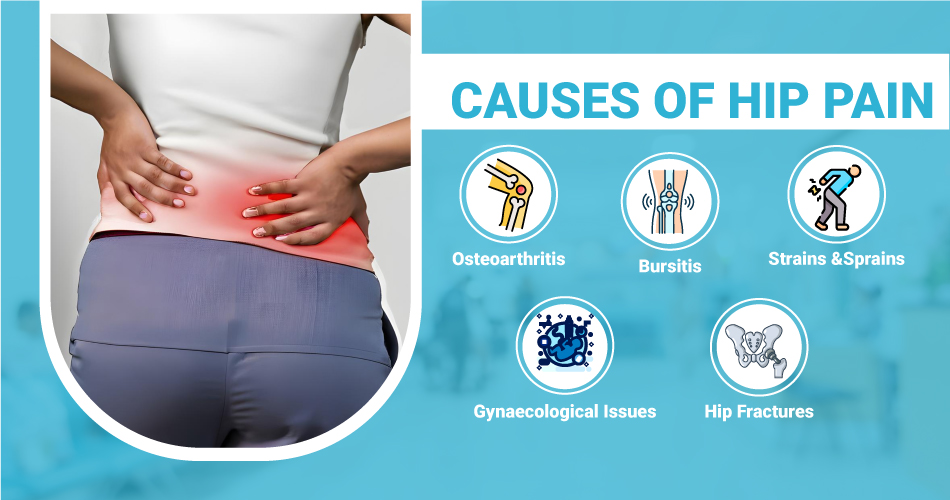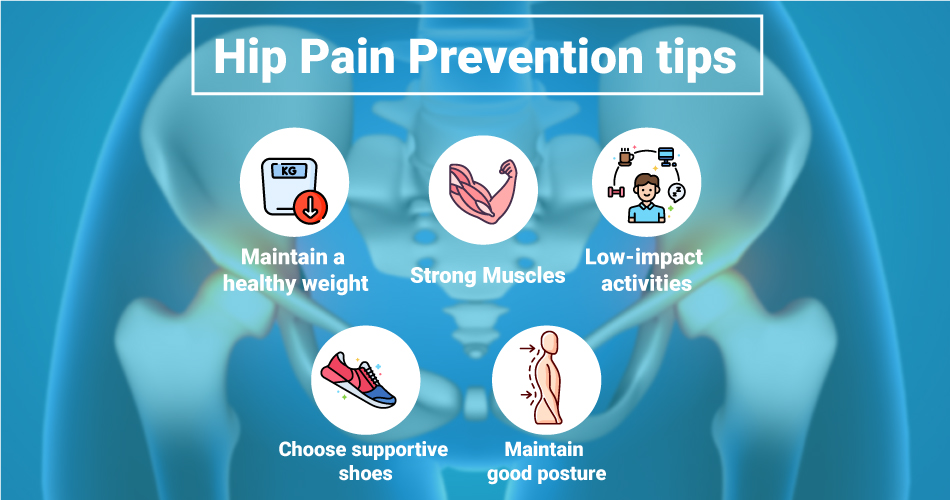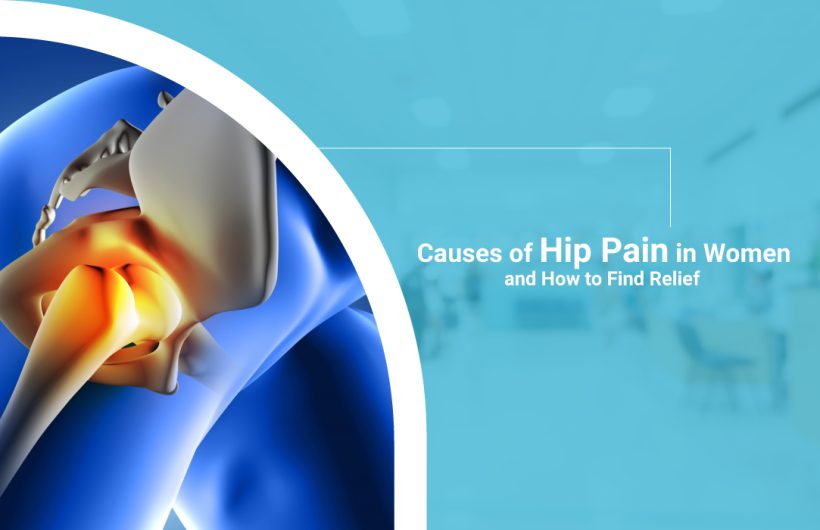Hip pain in women can be a debilitating condition that affects daily activities and quality of life. Whether it’s a dull ache or sharp discomfort, hip pain can significantly hinder mobility and overall well-being. Understanding the causes behind hip pain is crucial for effective management and finding relief. In this blog, we will explore five common causes of hip discomfort in women and discuss various treatments to alleviate discomfort and restore function.
Common Causes of Hip Pain in Women

Osteoarthritis
Osteoarthritis is one of the leading causes of hip pain in women, particularly as they age. This degenerative joint disease occurs when the cartilage cushioning the hip joint wears down over time, leading to pain, stiffness, and inflammation. As the condition progresses, bone spurs may develop, further exacerbating symptoms.
Hip discomfort caused by osteoarthritis is often characterized by stiffness in the morning or after periods of inactivity, decreased range of motion, and discomfort with weight-bearing activities. To find relief from hip discomfort associated with osteoarthritis.
Treatments
Treatments such as physical therapy, low-impact exercises, weight management, and over-the-counter pain medications. In severe cases, surgical options like hip replacement may be recommended to restore function and alleviate pain.
Bursitis
Bursitis is another common culprit behind hip pain in women. Bursae are small fluid-filled sacs that cushion the bones, tendons, and muscles around joints, including the hip. When these bursae become inflamed due to repetitive motions or excessive pressure, it can result in hip discomfort and tenderness.
Hip pain caused by bursitis is often localized to the outer hip area and may worsen with prolonged periods of standing, walking, or climbing stairs.
Treatments
Treatment for bursitis typically involves rest, ice therapy, nonsteroidal anti-inflammatory drugs (NSAIDs), and physical therapy to strengthen the muscles around the hip joint and improve flexibility. In some cases, a corticosteroid injection may be administered to reduce inflammation and alleviate pain.
Strains and Sprains
Strains and sprains of the muscles, ligaments, and tendons around the hip joint are common causes of acute hip discomfort in women, particularly athletes or individuals who engage in repetitive or high-impact activities. These injuries can occur suddenly due to a fall, sudden twist, or overexertion, leading to pain, swelling, and decreased mobility.
Hip pain caused by strains and sprains may vary depending on the severity of the injury but often presents as a sharp or throbbing pain in the hip or groyne area.
Treatments
Treatment typically involves rest, ice therapy, compression, and elevation (RICE protocol) to reduce pain and swelling. As the injury heals, gentle stretching and strengthening exercises prescribed by a physical therapist can help restore function and prevent recurrence.
Hip Fractures
Hip fractures are a serious cause of hip pain in older women, particularly those with osteoporosis or decreased bone density. A hip fracture usually occurs as a result of a fall or significant complex trauma and requires prompt medical attention.
Hip pain caused by a fracture is severe and often accompanied by swelling, bruising, and an inability to bear weight on the affected leg.
Treatments
Treatment for hip fractures typically involves surgery to realign the fractured bones and stabilize the hip joint with implants or hardware. Following surgery, rehabilitation and physical therapy are essential to regain strength, mobility, and independence.
Gynaecological Issues
In some cases, hip pain in women may be related to underlying gynaecological conditions such as endometriosis, ovarian cysts, or pelvic inflammatory disease (PID). These conditions can cause referred hip pain due to inflammation or irritation of nearby structures.
Hip discomfort associated with gynaecological issues may be accompanied by other symptoms such as pelvic pain, irregular menstrual cycles, or pain during intercourse.
Treatments
Treatment for hip pain related to gynaecological conditions depends on the underlying cause and may include medication, hormone therapy, or surgical intervention.
Role of Orthopedic in Relieving Hip Pain
Orthopedic specialists play a pivotal role in diagnosing and treating hip pain. Through thorough evaluation and imaging, they pinpoint the source of discomfort, prescribing medications and designing tailored physical therapy regimens. Minimally invasive procedures and surgeries are utilized when necessary, such as hip replacements or repairs. Orthopedic surgeons also educate on preventive measures and lifestyle adjustments to manage pain effectively, providing comprehensive care from diagnosis to rehabilitation for optimal patient outcomes.
Prevention Strategies For Hip Pain

Hip pain can be a major hindrance to our daily lives. While some causes may require medical attention, many proactive measures can help prevent hip pain and keep you moving freely.
- Maintain a healthy weight: Excess weight puts significant strain on the hip joints. Aiming for a healthy weight can significantly reduce stress and risk of osteoarthritis, a major contributor to hip pain.
- Strong muscles: Regularly performing strength training exercises, focusing on glutes, hamstrings, and quadriceps, can significantly improve hip stability and support.
- Low-impact activities: Activities like swimming, cycling, and walking are excellent for maintaining cardiovascular health and joint health without putting undue stress on the hips.
- Listen to your body: Don’t push through pain. If you experience any discomfort during an activity, stop and rest. Pushing through pain can lead to further injury or aggravate existing conditions.
- Choose supportive shoes: Invest in well-fitting shoes with good arch support and cushioning to absorb shock and distribute weight evenly while walking or running.
- Maintain good posture: Standing and sitting with proper posture, with your back straight and core engaged, can help distribute weight evenly throughout your body and prevent strain on your hip joint.
Prevention is key to maintaining healthy, pain-free hips. By incorporating these strategies into your daily life, you can significantly reduce your risk of hip pain and keep yourself moving confidently for years to come.
Conclusion
In conclusion, hip pain can significantly impact daily life, but with proper care and treatment, relief is attainable. Consulting an orthopedic doctor is crucial for an accurate diagnosis and personalized treatment plan. In Ahmedabad, Dr. Hardik Padhiyar stands out as a leading orthopedic surgeon specializing in hip pain management. His expertise and dedication make him a trusted resource for individuals seeking relief. With the right support and guidance, individuals can overcome hip discomfort and regain mobility, enhancing their overall quality of life.






